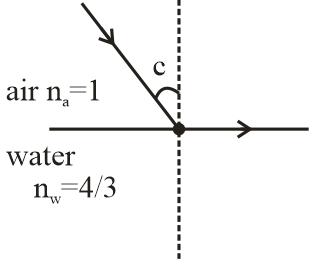
The absolute refractive index of water is $\dfrac{4}{3}$. What is the critical angle ?
Answer
571.8k+ views
Hint: Critical angle is defined as the angle of incidence beyond which rays of light passing through a denser medium to the surface of a less dense medium are no longer refracted but totally reflected and numerically it is given as $c = {\sin ^{ - 1}}\left( {\dfrac{{{n_r}}}{{{n_i}}}} \right)$
Where
c $ = $ critical angle
${n_r} = $ refractive index of medium where ray will be refracted
${n_i} = $ refractive index of medium where ray is incident
Complete step by step answer:
The absolute refractive index is defined as the ratio of the speed of light in vacuum and in the given medium. It should never be less than 1.
Given that the absolute refractive index of water is $ = \dfrac{4}{3}$.
Now we have to find critical angle
Critical angle is the angle of incidence beyond which the total internal reflection of light occurs.
Total internal reflection is a phenomenon in which the incident ray becomes completely reflected

In the diagram, we can easily see that the ray becomes completely reflected. So, the critical angle is given as
$\sin c = \dfrac{{{n_r}}}{{{n_i}}}$
Here ${n_r} = {n_w} = \dfrac{4}{3}$
${n_i} = {n_a} = 1$
So, $\sin c = \dfrac{1}{{4/3}} = \dfrac{3}{4}$
$c = {\sin ^1}\left( {\dfrac{3}{4}} \right)$
$c = 48.5$
Note:
Total internal reflection occurs only when light is travelling from rarer medium to denser medium.
When light travels from rarer to denser medium then it is moving far away from normal.
When light travels from denser to rarer medium then it is moving towards normal.
Where
c $ = $ critical angle
${n_r} = $ refractive index of medium where ray will be refracted
${n_i} = $ refractive index of medium where ray is incident
Complete step by step answer:
The absolute refractive index is defined as the ratio of the speed of light in vacuum and in the given medium. It should never be less than 1.
Given that the absolute refractive index of water is $ = \dfrac{4}{3}$.
Now we have to find critical angle
Critical angle is the angle of incidence beyond which the total internal reflection of light occurs.
Total internal reflection is a phenomenon in which the incident ray becomes completely reflected

In the diagram, we can easily see that the ray becomes completely reflected. So, the critical angle is given as
$\sin c = \dfrac{{{n_r}}}{{{n_i}}}$
Here ${n_r} = {n_w} = \dfrac{4}{3}$
${n_i} = {n_a} = 1$
So, $\sin c = \dfrac{1}{{4/3}} = \dfrac{3}{4}$
$c = {\sin ^1}\left( {\dfrac{3}{4}} \right)$
$c = 48.5$
Note:
Total internal reflection occurs only when light is travelling from rarer medium to denser medium.
When light travels from rarer to denser medium then it is moving far away from normal.
When light travels from denser to rarer medium then it is moving towards normal.
Recently Updated Pages
A man running at a speed 5 ms is viewed in the side class 12 physics CBSE

The number of solutions in x in 02pi for which sqrt class 12 maths CBSE

State and explain Hardy Weinbergs Principle class 12 biology CBSE

Write any two methods of preparation of phenol Give class 12 chemistry CBSE

Which of the following statements is wrong a Amnion class 12 biology CBSE

Differentiate between action potential and resting class 12 biology CBSE

Trending doubts
What are the major means of transport Explain each class 12 social science CBSE

Which are the Top 10 Largest Countries of the World?

Draw a labelled sketch of the human eye class 12 physics CBSE

Explain sex determination in humans with line diag class 12 biology CBSE

Explain sex determination in humans with the help of class 12 biology CBSE

Differentiate between homogeneous and heterogeneous class 12 chemistry CBSE




